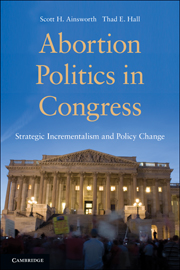Book contents
- Frontmatter
- Contents
- Tables
- Figures
- Acknowledgments
- Part I Strategic Incrementalism and the Political Backdrop for Abortion Politics in Congress
- 1 Some of the Politics Surrounding Abortion Policy
- 2 The Strategic Foundations for Incrementalism in Legislatures
- 3 The Nature of Congress and Incrementalism in Abortion Politics: Views from the Inside and Views from the Outside
- 4 A Short Legislative History of Abortion
- Part II Abortion in the House
- References
- Index
1 - Some of the Politics Surrounding Abortion Policy
Published online by Cambridge University Press: 05 June 2012
- Frontmatter
- Contents
- Tables
- Figures
- Acknowledgments
- Part I Strategic Incrementalism and the Political Backdrop for Abortion Politics in Congress
- 1 Some of the Politics Surrounding Abortion Policy
- 2 The Strategic Foundations for Incrementalism in Legislatures
- 3 The Nature of Congress and Incrementalism in Abortion Politics: Views from the Inside and Views from the Outside
- 4 A Short Legislative History of Abortion
- Part II Abortion in the House
- References
- Index
Summary
[T]he abortion issue poses constitutional problems not simply for judges but for every federal, state, or local official who must at some point address the issue. (Tribe 1992, 77)
Introduction
When the Supreme Court upheld the congressional Partial-Birth Abortion Ban Act in Gonzales v. Carhart, Robin Toner wrote in the New York Times that the case represented a successful new tactic in abortion politics (2007). Both the U.S. Congress and the Supreme Court accepted a new understanding, or framing, of the abortion issue. Abortion was, at least for the moment, framed as being a danger to the interests of women. Pro-life groups had sought to reframe the abortion debate along these lines for some time. Indeed, proponents on each side of the issue have sought to control the language used to describe a fetus – language that is then sometimes reflected in law.
How did abortion move from an issue of choice or an issue of morality to an issue that – judged by the Supreme Court – posed dangers for women? The framing and reframing of the abortion issue has been ongoing for decades. Legislators, judges, the public, and those individuals most directly affected by abortion procedures have understood and explained the issues tied to abortion in diverse ways. The framing of the abortion debate in the 1800s maintained that the practice was wrong unless medically necessary, which was best determined by a licensed physician. The conflict at this time was not simply grounded on moral argument; there was considerable tension between doctors and midwives over the provision of medical services to women (e.g., Craig 1993). Abortion politics was enmeshed in the debates about who should be allowed to practice medicine and whether physicians should be granted market protections. In the end, the doctors won the argument and, by 1910, abortions were illegal in all states except one and in all cases except when the abortion was necessary to save the life of a woman.
- Type
- Chapter
- Information
- Abortion Politics in CongressStrategic Incrementalism and Policy Change, pp. 3 - 26Publisher: Cambridge University PressPrint publication year: 2010



